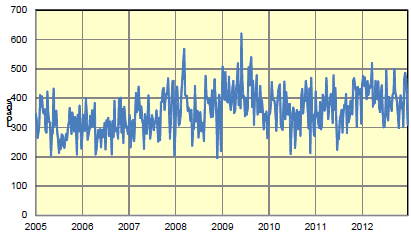



CME: MPR for Wholesale Pork Off and Running
US - The first reports from USDA’s new mandatory price reporting (MPR) system for pork were released on Monday and to say they are “different“ would be a huge understatement, write Steve Meyer and Len Steiner.Consider:
- The afternoon mandatory report (LM_PK602) covered 552.8 loads of product compared to the 91.5 loads covered in the voluntary report. The 552.8 loads in the 7 January mandatory report is more volume that was reported in every week except two since January 2005. See the chart below.

- The 7 January afternoon mandatory system report contained prices for 114 pork cuts. The voluntary report contained prices for 24 pork cuts. It is clear that USDA is trying to get prices on FAR MORE cuts under the mandatory system as the report has, by our count, 288 individual line items under regular pork cuts and another 48 for cuts with added ingredients. It should be noted that the prices of another 60 regular cuts and 13 added-ingredient cuts could not be published due to confidentiality rules.
The cutout value (recall that this is the value of the carcass
per one hundred pounds (cwt.) based on the value of all of the cuts that
come from a carcass) for the items reported under MPR was $86.97/
cwt. The cutout for the voluntary report was $83.68/cwt., $3.29 lower.
The higher MPR cutout value is a surprise to many since the assumption
has always been that packers had a terrific incentive to report the
highest possible wholesale cut prices under the voluntary system since
formula- and contract-price products were based on the report. There
is no guarantee that the relationship will continue but the fact that it happened
tells us that what we thought we might see from this new system
may not be the same as what actually happens!
One point needs to be remembered about the cutout value.
The MPR cutout is based on updated cut yields from packers while the
voluntary value is based on the same yields that have been used for
several years. One side benefit of the MPR system is packers’ agreeing
to supply up-do-date cut yield data on an annual basis. Accurate
yields are not crucial to price reporting, per se, but they are important
for both packers and producers who may use the cutout value to determine
at least part of the value of pigs.
A look at belly prices reported on 7 January is, we think, both
interesting and , to some degree, maddening! The voluntary report
contained one quote: 14-16 pound skin-on bellies at $135. The mandatory
report contained prices for 9 different belly products with prices ranging from $120 to $227 and weighted average prices for the 9 products
ranging from $126.60 to $200. What is interesting is that there is
no quote in the mandatory report for 14-16 pound, skin-on bellies. It is
possible that the quote in the voluntary report came from a packer not
covered under the mandatory system but the difference in the amount
of information available is astounding. And consider this — the mandatory
report included 1.399 million pounds of de-rind (ie. skinned) bellies
and only 64,400 (ie. 0.064 million pounds!) of skin-on bellies. That is
18.8 times as many skinned bellies even though, for years belly sellers
and buyers insisted that they must have a skin-on price because it was
the basis for formula prices.
The one week delay in publishing the prices is designed to
keep voluntary system functioning while mandatory data is generated.
The reason is that both sellers and buyers need some time to figure out
how prices from the two reports differ so they can adjust their formula
and contract prices. How long the parallel systems will last is a current
point of debate. USDA announced that it would begin publishing the
MPR data on the day it is generated on 28 January. At least some of
the parties to the negotiated rulemaking process that set the MPR rules
believe that USDA is reneging on a commitment to maintain the side-by
-side systems for much longer — at least 6 months. All affected parties
are now talking so stay tuned for changes to that timeline. It does
seem counterintuitive to have all of this new information and then delay
its publication but knowing how the new data differs from the old is important.
When MPR for hogs began in 2001, many hog contracts were
tied to the mid-morning voluntary report. It went away in an instant and
was replaced with a report whose weighted average price was generally
lower than had been observed before that time. With no overlapping
data and few contract clauses allowing for re-negotiation, the change
caused a great deal of animosity and no small amount of financial loss.








